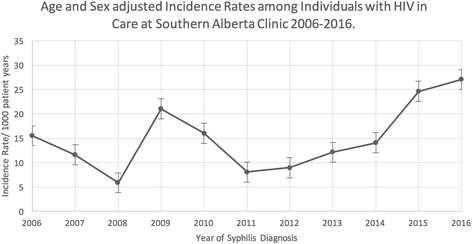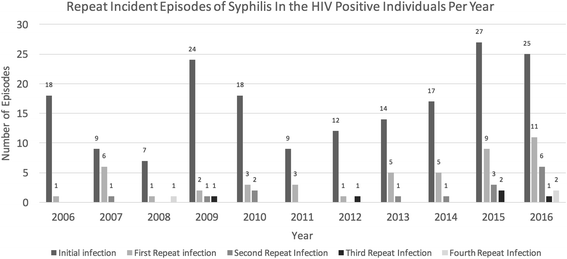Increasing incidence of syphilis among patients engaged in HIV care in Alberta, Canada: a retrospective clinic-based cohort study
- PMID: 29534681
- PMCID: PMC5851255
- DOI: 10.1186/s12879-018-3038-4
Increasing incidence of syphilis among patients engaged in HIV care in Alberta, Canada: a retrospective clinic-based cohort study
Abstract
Background: Syphilis is a global health concern disproportionately affecting HIV-infected populations. In Alberta, Canada, the incidence of syphilis in the general population has recently doubled with 25% of these infections occurring in HIV-infected patients. The Southern Alberta HIV Clinic (SAC) and Calgary STI Program (CSTI) analyzed the epidemiologic characteristics of incident syphilis infections in our well-defined, HIV-infected population over 11 years.
Methods: Since 2006, as routine practice of both the Southern Alberta Clinic (SAC) and Calgary STI Programs (CSTI), syphilis screening has accompanied HIV viral load measures every four months. All records of patients who, while in HIV care, either converted from being syphilis seronegative to a confirmed seropositive or were re-infected as evidenced by a four-fold increase in rapid plasma reagin (RPR) after past successful treatment, were reviewed.
Results: Incident syphilis was identified 249 times in 194 HIV-infected individuals. There were 36 individuals with repeated infections (28.5% of episodes). Following a prior decline in annual incident syphilis rates, the rates have tripled from 8.08/1000 patient-years (95% confidence interval (CI): 4.14-14.75) in 2011, to 27.04 per 1000 person-years (95% CI: 19.45-36.76) in 2016. Half of the syphilis episodes were asymptomatic. Patients diagnosed with syphilis were twice as likely not to be taking ART and had a higher likelihood of having plasma HIV RNA viral loads > 1000 copies/mL (19%). Incident syphilis was seen predominantly in Caucasians (72%, P < 0.001), males (94%, P < 0.001) and men who have sex with men (MSM) as their HIV risk activity (75%, P < 0.001).
Conclusions: We have highlighted the importance of a regular syphilis screening program in HIV-infected individuals demonstrated by increasing rates of incident syphilis in our region. Targeted preventative strategies should be directed towards HIV-infected populations identified at highest risk, including; MSM, prior alcohol abuse, prior recreational drug use and those with prior syphilis diagnoses.
Keywords: Canada; HIV/AIDS; Incidence; Syphilis.
Conflict of interest statement
Ethics approval and consent to participate
Ethics approval was obtained through the University of Calgary Bioethics committee as a quality assurance project through A Project Ethics Community Consensus Initiative (ARECCI). Approval was granted both verbally and written on Aug 23, 2016. Informed consent was deemed unnecessary as per ethics approval via ARECCI do to the non-identifying nature of this grouped data.
Consent for publication
Not applicable.
Competing interests
We have no relevant conflicts of interest to disclose. This research was presented at CROI 2017 in Seattle, WA as a poster.
Publisher’s Note
Springer Nature remains neutral with regard to jurisdictional claims in published maps and institutional affiliations.
Figures


References
-
- World Health Organization. (2012) Global incidence and prevalence of selected curable sexually transmitted infections – 2008. http://www.who.int/reproductivehealth/publications/rtis/stisestimates/en/. Accessed 2 Nov 2016.
-
- Alberta Government. Sexually transmitted infections have reached outbreak levels in Alberta. 2016 Apr 26. https://www.alberta.ca/release.cfm?xID=4163947EECDEA-024A-0016-6E2A2E61E.... Accessed 2 Nov 2016.
MeSH terms
Substances
LinkOut - more resources
Full Text Sources
Other Literature Sources
Medical
Miscellaneous

